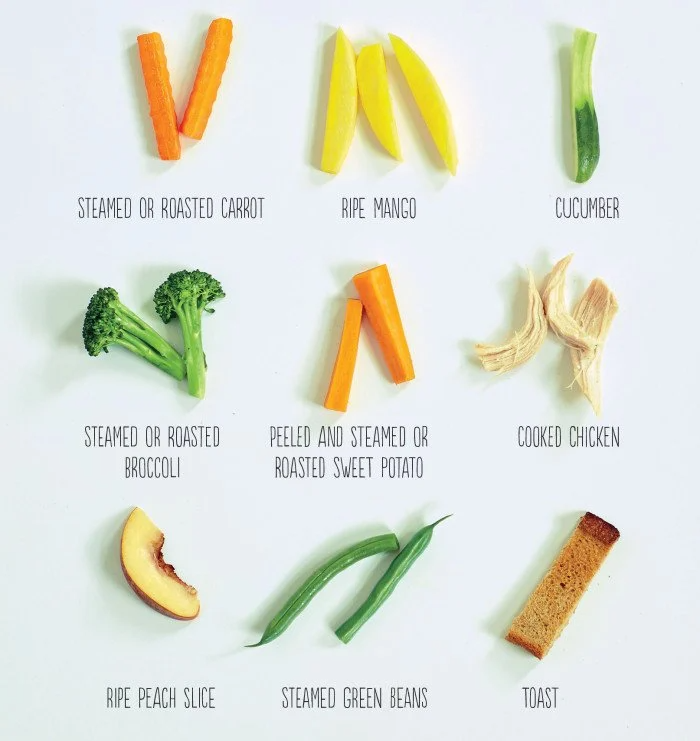Baby led weaning food sizes
Ultimate Guide to Baby Led Weaning (and Best First Foods)
Learn the basics of how to do the feeding approach known as “baby led weaning” and the best first foods for baby to make starting solids easy and fun. Plus: Learn why it’s perfectly okay to use a combined approach of blw and purees.
Baby Led Weaning
The feeding approach known as “baby led weaning” or “BLW” for short, is a style of feeding infants that allows them to feed themselves right from the start. The food is offered in thick finger-size pieces and is soft and easily squishable between your fingers. This way, the food is both easy to hold but has a low risk of choking.
TIP: This method became popular about a decade ago after the publication of the Baby Led Weaning: The Essential Guide to Introducing Solid Food by UK author Gill Rapley.
BLW Baby
One of the many reasons that people are starting to opt for this style of feeding more and more is simply that it’s easy. In many cases, you can modify foods you’re already making to share with your baby and there’s not always a lot of separate cooking involved. It also allows a baby to have control over what goes into their mouths, which sets a good precedent for letting them eat intuitively from the start.
What age should I start baby led weaning?
According to the American Academy of Pediatrics, a baby is ready to start solids with baby led weaning when:
- They’ve doubled their birth weight (at least).
- They can hold their head up well and are starting to sit up unsupported.
- They show signs of being interested in food (watching you eat, reaching for food when you’re eating, etc).
- When you feed them, they are able to move the food around in their mouths—rather than spit it right out.
TIP: Look for a highchair that allows a baby to sit up relatively straight so they can have good posture and better control over their arms and hands.
How to Start Baby Led Weaning
The first time you offer solids is such a fun milestone, so you’ll be ready once you follow these simple steps.
- Make sure baby has hit the milestones listed above to let you know that he’s ready to start.
- Get the highchair ready and adjust the straps and foot rest as needed.
- Plan to introduce water when you start solids. I recommend a trainer cup.
- Choose one food to start with and plan to offer only one food at a time.
- Stop when baby starts to fuss, turns his head away, or shows any other signs of not wanting to continue. It’s usually fairly obvious when they are done!
TIP: If you start offering solids and baby just doesn’t seem interested at all, it’s okay. Take a break for a few days or a few weeks and start again. Each kiddo has their own unique timeline.
Best Tips for Starting BLW
Here are a few more tips to consider and review before you get started.
- Understand the gag reflex. Gagging is different than choking though and is most often a sign that baby is learning to move food around in their mouths—and to get it out of their mouths, which is a skill you want them to have!
- Brush up on the basics of how to know when baby is ready to start solids. (Go back to the top of this post for the signs to look for.)
- Set them up for success with a highchair that allows them to sit up straight and has foot support.
- Sit with them as you offer food.
- Check your own expectations of what will happen and simply allow your baby to take the lead.
- Start with one new food a day or every few days.
- Vary the textures of foods you offer to start exposing baby to many right from the start.
- Offer water in a sippy cup or small open cup.
TIP: Remember that breastmilk or formula will continue to satisfy baby’s hunger for the first few months of eating solids. Do not expect solids to replace milk feedings at this age.
First Foods for Baby
Starting solids with baby led weaning or purees are both perfectly acceptable ways to introduce a baby to solid foods—but the topic can get so heated! There’s a lot of pressure to do it the “right” way and I’m here to say that there isn’t one. You 100% can do one or the other, or combine the two to make it work for your family. It’s all good!
Remember, the goal with first foods for baby is that they’re introduced to flavors, nutrients, and foods they can easily eat or suck on. It should be an enjoyable milestone for all involved.
TIP: It’s a good idea to get into the habit of offering an iron-rich food since iron stores in babies start to run out around 6 months and they’ll need to start ingesting it in their food.
Best First Foods for Baby Led Weaning
Here are some of our favorite first foods to offer baby led weaning style. You want foods to be finger sized so they are large enough that baby can’t force the whole piece into their mouth, and a shape that’s easy for a 6 month old to hold with their chubby little hands.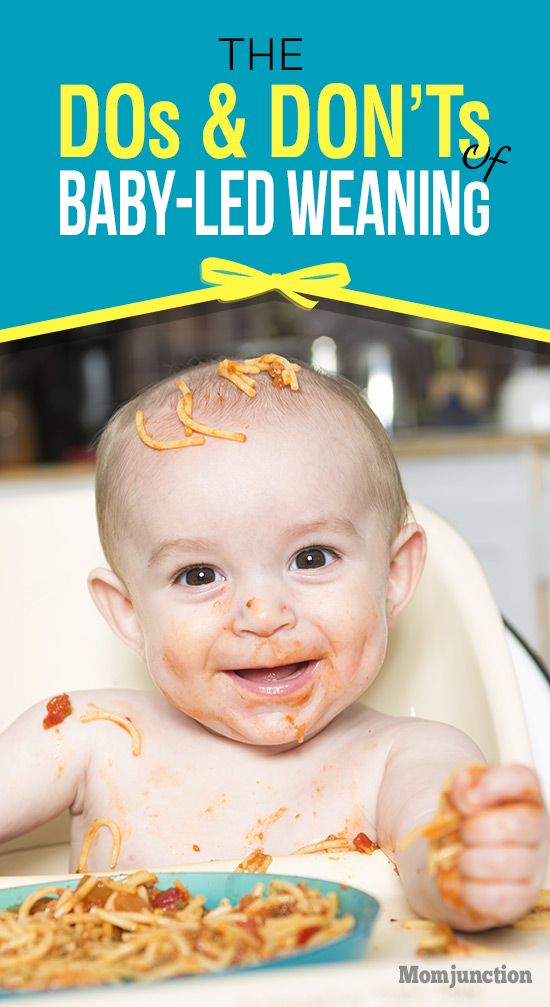 These are some of our favorites.
These are some of our favorites.
- Roasted sweet potato wedges
- Roasted apple wedges, skin on to help them hold together
- Roasted or steamed broccoli florets (big enough for baby to hold)
- Melon slices
- Thick mango slice
- Banana with some of the peel still on
- Toast sticks with mashed avocado
- Avocado spears (make sure the avocado is ripe and soft)
- Lamb or beef, on the bone or a large piece for baby to suck on
- Dark meat chicken, on the bone or a large piece for baby to suck on.
TIP: The foods should generally be soft enough to squish between your fingers with the exception of the large pieces of meat. If baby gnaws a piece down into a smaller piece, replace it with a larger one to avoid her putting a chunk of food into her mouth.
Baby Led Weaning Banana
To serve a banana to a baby, wash it well, then slice it in half. Cut off an inch or two of the peel, but leave the rest of the peel on so it’s not slippery for baby to hold. They’ll suck on the top part like a little popsicle! You can also help them hold the banana if needed.
They’ll suck on the top part like a little popsicle! You can also help them hold the banana if needed.
Foods to Avoid Serving While Doing BLW
You want any foods you offer to a baby while doing baby led weaning to be soft enough to squish between your fingers and safe for them to eat and digest. Plan to avoid:
- Anything hard, sticky, or crunchy (like raw apple or carrot, whole nuts, crackers, or a big spoonful or nut butter)
- Added salt
- Cow’s milk (which is difficult for kids under 1 to digest; plain yogurt is fine though)
- Added sugar (they simply don’t need it)
- Honey (to avoid a risk of botulism)
- Super slippery foods that would be hard for baby to hold (which can be frustrating)
TIP: Always sit with your baby and watch them try to eat. They are your best guide for making adjustments to the foods you serve.
Baby Led Weaning and Choking
There are many parents who dislike this method of feeding because it often sounds like a baby is choking.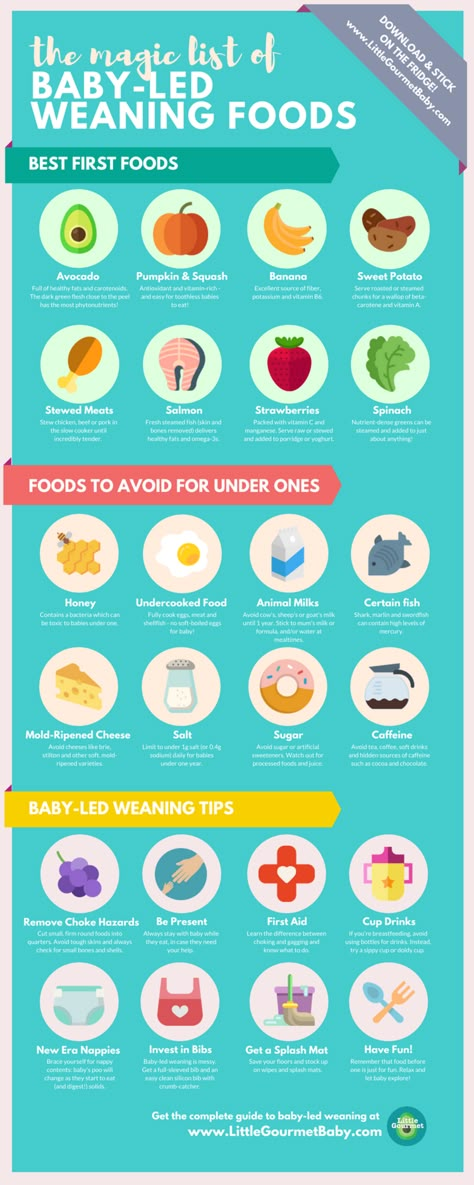 And while there are surely some incidences of choking, what’s more likely is that a baby will occasionally gag on a piece of food that gets into their mouth that they weren’t expecting.
And while there are surely some incidences of choking, what’s more likely is that a baby will occasionally gag on a piece of food that gets into their mouth that they weren’t expecting.
But remember: Gagging is a sign that baby is doing what she needs to in order to move the food around in their mouth as they learn to eat. It usually sounds more dangerous than it actually is.
TIP: If the sound of gagging really freaks you out, you’re not alone. Consider offering more preloaded spoons with purees to start your journey more slowly.
How to Cut Foods for BLW
You generally want the food to be big enough that it would be difficult for baby to put the entire thing into their mouths. Here are some specifics:
- Foods that are roughly the size of a finger, so about a 4-inch stick.
- Foods that are easy for the baby to pick up—they can’t pick up small pieces until closer to 9 months when they develop the ability to use their fingers in what’s known as a “pincer grasp”.
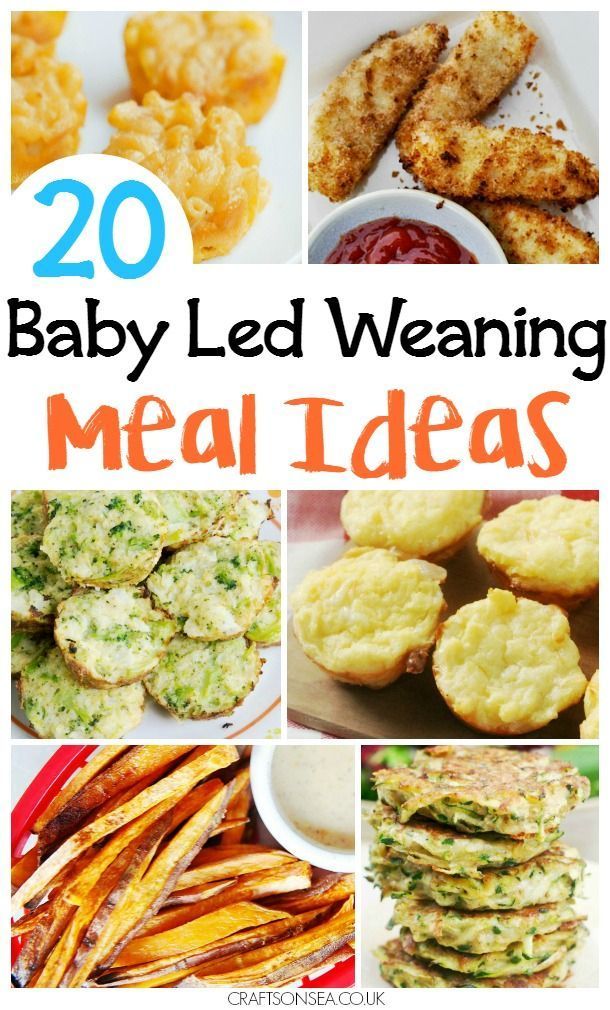
- Foods that aren’t too slippery—so you can wash and leave some of the peel on fresh foods like bananas, avocado, kiwi, and mango.
TIP: You can also go even bigger if you’re worried about size. Think half of a slice of bread or a big chunk of watermelon.
Will my baby actually eat much food with BLW?
Probably not at first. There will likely be more tasting of the food than eating of it and that is totally fine. They will still rely on breast milk or formula at this age for their main nutrition, so don’t expect them to suddenly start eating full meals. (They’ll get there in a few months, but it takes time!)
Do babies need teeth for baby led weaning?
No! Gums are super strong and front teeth aren’t used for chewing—that happens when the back molars come in. Teeth really have nothing to do with whether or not a baby can eat solids.
TIP: Learn more about what to expect from teething here.
Can you mix baby led weaning and purees?
Absolutely! I think it’s a great idea to mix the two methods simply because it gives you many more options for foods and allows the baby to experience more textures.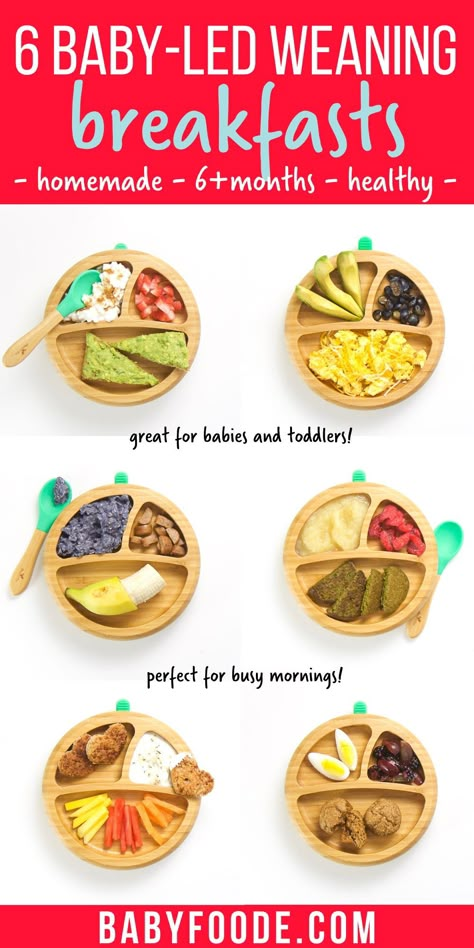 I recommend allowing babies to feed themselves preloaded spoons—so you put the puree on a spoon, then hand it to them to actually put the spoon into their mouth—so they still have control over what goes into their mouths.
I recommend allowing babies to feed themselves preloaded spoons—so you put the puree on a spoon, then hand it to them to actually put the spoon into their mouth—so they still have control over what goes into their mouths.
TIP: Feeding some purees is also helpful if you’ll be sending food with a baby to daycare since the care provider may not have experience with blw.
Best First Foods for Baby: Purees
Here are some of our favorite purees to start offering baby when they’re ready to start solids. Remember: There’s no evidence that says that you need to start with vegetables versus fruits, so go with something that tastes good to you. Start with single foods pureed smooth and offer just a little at a time on a spoon.
- Mashed roasted sweet potato puree
- Mashed avocado puree
- Mashed banana puree
- Butternut squash puree
- Applesauce, unsweetened
- Mashed pea puree
- Oatmeal baby cereal (with added iron)
TIP: One of my favorite baby food companies is Amara Organic Baby Food, a company using a nutrient protection technology that makes organic purees just as good as homemade.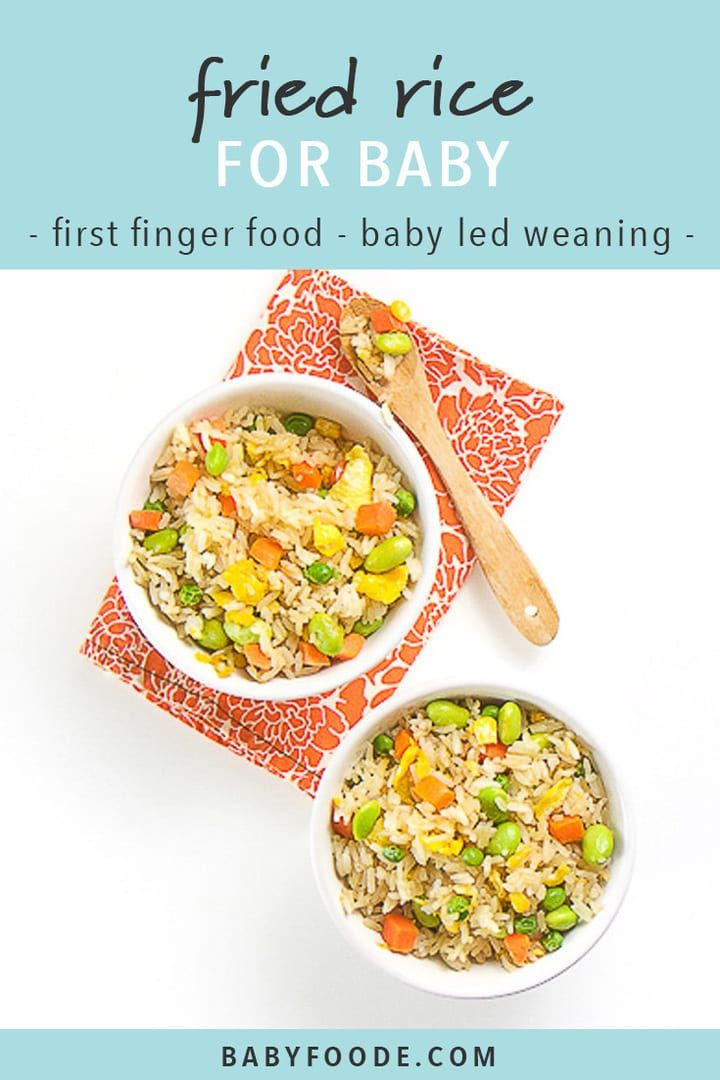 I love how easy they are to use when I need a shortcut and that they have fun baby-led weaning recipes on the side of every box! (paid affiliate link)
I love how easy they are to use when I need a shortcut and that they have fun baby-led weaning recipes on the side of every box! (paid affiliate link)
How do I know when baby has had enough?
If your baby is eating and then starts to turn her head away or just refuses to open her mouth, she’s done! Babies may also start to fuss if they’ve had enough. Learning this new skill takes time and babies can become tired fairly quickly into the process, so don’t expect them to always eat very much or to last very long at the table. This stage is about exploration!
Baby with preloaded spoon of yogurtHow to Let Baby Self Feed Purees
I love offering purees on a preloaded spoon. To do this, the parent, puts some of the food on the spoon and hands it to baby. Then baby can bring the food to their mouth all by themselves. This gives you some of the same advantages of baby led weaning, but can be more comfortable for many parents.
Remember, you can mix what you offer, going back and forth between purees and blw finger foods, so you can offer the same food two different ways to let baby explore.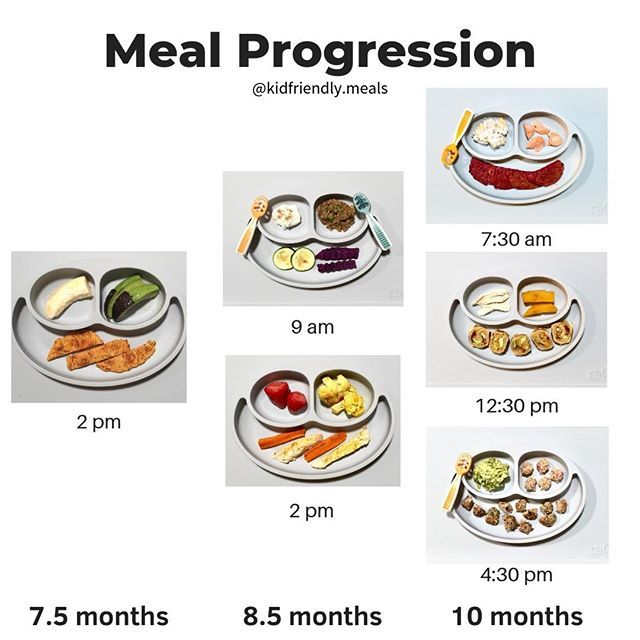 The main goal is to avoid forcing baby to take more bites than they want to, which can sometimes happen with purees.
The main goal is to avoid forcing baby to take more bites than they want to, which can sometimes happen with purees.
When to Introduce Potentially Allergenic Foods
In recent years, guidelines have been updated on when to introduce potential allergens including peanuts, eggs, and shellfish, so unless you have a family history of a food allergy, you can go ahead and introduce them soon after baby starts eating solids. In fact, research is showing that introducing these foods early can actually protect baby from developing an allergy. Talk to your pediatrician if you have concerns.
TIP: Thin unsweetened peanut butter with water to form a very thin Peanut Butter Puree until it’s about the consistency of regular yogurt and offer a very small amount on a spoon or spread on a toast stick.
What does a baby led weaning meal look like for months 7 and 8?
Until a baby is closer to 9 months and is able to pick up smaller pieces of foods, but after they have gotten the hang of one food at a time, I try to offer 1-2 foods they can feed themselves and one puree. This offers them a chance to ingest more via the puree but still feed themselves a range of textures. You can do more or less food following the lead of the child.
This offers them a chance to ingest more via the puree but still feed themselves a range of textures. You can do more or less food following the lead of the child.
TIP: My Baby Food Chart has loads of with ideas for blw foods and purees by month.
Recipes for Every Stage of Starting Solids
If you’re ready to start solids with baby, or you’re just curious what it looks like to do a mix of baby led weaning and purees, check out my Yummy Baby Food cookbook. It goes stage by stage with specific foods to start in each, with simple recipes and easy feeding tips.
Listen to a recent podcast episode to hear about some of the basics of BLW with our guest Megan McNamee, MPH, RDN, CLT, and a Registered Dietitian Nutritionist specializing in pediatric nutrition who runs Feeding Littles.
I’d love to hear any questions you have with BLW or if your baby had a first food that I didn’t list here. Please comment below to share your experience!
Prep Time 5 minutes
Total Time 5 minutes
Author Amy Palanjian
Cuisine American
Course Dinner
Calories 28kcal
Servings 1
Banana
- ▢ 1 small ripe banana with peel on
Roasted Sweet Potato
- ▢ 1 small sweet potato + 1 teaspoon olive oil
Roasted Apple
- ▢ 1 small apple + 1 teaspoon butter or neutral oil
Roasted Broccoli
- ▢ 1 cup broccoli florets + 1 teaspoon olive oil
Sauteed Green Beans
- ▢ 4 green beans 1 teaspoon olive oil
Melon
- ▢ 1 small piece watermelon or cantaloupe
Avocado Toast
- ▢ 1 slice whole grain bread
- ▢ 1 tbsp ripe avocado
Avocado Spear
- ▢ ⅛ ripe avocado
Lamb or Beef
- ▢ 1 lamb chop, roast, or steak
Pan-Seared Chicken Thighs
- ▢ 1 chicken thigh
- ▢ 1 tsp olive oil
- ▢ 1 garlic clove, optional
Banana with some of the peel still on
Cut a banana in half.
 Use a knife to gently cut around the peel about 2 inches down, leaving some of the peel on so that the banana is easy for baby to hold and less slippery.
Use a knife to gently cut around the peel about 2 inches down, leaving some of the peel on so that the banana is easy for baby to hold and less slippery.
Roasted Sweet Potato Wedges
Preheat oven to 400 degrees and line a rimmed baking sheet with foil. Wash and dry the sweet potato. (You don't need to peel it.) Cut in half, then cut lengthwise into strips. Cut each strip in half again until each is about 1/2-inch thick. Slice in half horizontally if the sweet potato is very long. (Each strip should be about the size of your finger.) Place into a bowl and toss with the olive oil. Spread onto prepared baking sheet and roast for 22-25 minutes or until soft. Let cool slightly and serve.
Roasted Apple Wedges
Roasted Broccoli Florets
Preheat the oven to 400 degrees F. Place the broccoli onto a rimmed baking sheet and toss with the olive oil, coating and mixing well until all of the florets are a little shiny and coated with oil.
 Roast for 15-18 minutes or until tender. Let cool slightly and serve.
Roast for 15-18 minutes or until tender. Let cool slightly and serve.
Sauteed Green Beans
Warm the oil in a large skillet over medium heat. Add the green beans and stir. Cover and cook for about 8 minutes. Remove cover and taste one to see if it’s soft enough. Cook for an additional minute or two as needed.
Melon slices
Avocado Toast
Avocado Spears
(Make sure the avocado is ripe and soft): Cut a thick strip of avocado and offer to baby. You can leave the peel on if that makes it easier for baby to hold (just wash it first).
Lamb or Beef
Prepare a roast, steak, or chop without salt and with butter or olive oil until cooked medium well. Offer a thick slice at least the size of your finger or a drumstick.
Pan-Seared Chicken Thighs
Warm 1 tablespoon olive oil or butter in a large skillet over medium heat. Add the chicken thigh and top with a few slices of fresh garlic, if desired.
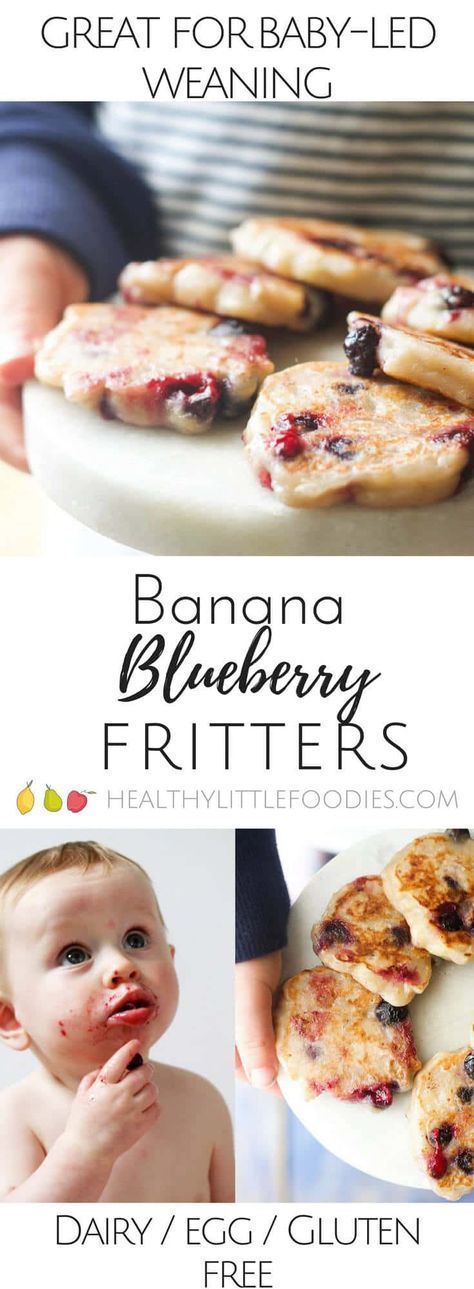 Cover and cook for 4-5 minutes. Remove cover. Flip over and cook for an additional 4-5 minutes uncovered or until a meat thermometer registers 165 degrees F.
Cover and cook for 4-5 minutes. Remove cover. Flip over and cook for an additional 4-5 minutes uncovered or until a meat thermometer registers 165 degrees F.
- Add spices like garlic powder, cinnamon, cumin, oregano, or any other non-spicy flavor you like to make these more interesting.
- Offer just one piece at a time when starting out.
- If baby gnaws a piece down into a smaller piece, replace it with a larger one to avoid her putting a chunk of food into her mouth.
- Store any leftovers in an airtight container in the fridge for 3-5 days. Reheat briefly if needed.
- Remember that it's normal for babies to take time to actually ingest the food. Part of the process is exploring all of the senses related to the experience of eating.
Calories: 28kcal, Carbohydrates: 2g, Protein: 1g, Fat: 2g, Saturated Fat: 1g, Polyunsaturated Fat: 1g, Monounsaturated Fat: 2g, Sodium: 6mg, Potassium: 75mg, Fiber: 1g, Sugar: 1g, Vitamin A: 23IU, Vitamin C: 2mg, Calcium: 2mg, Iron: 1mg
Tried this recipe?Rate in the comments and tag @yummytoddlerfood on IG!
50+ Best Finger Foods for Babies (and Toddlers)
Introducing finger foods to your baby can be exciting and overwhelming! Here is everything you need to know about serving finger foods so that they are safe and delicious!
Jump to:- Baby Finger Foods - FAQ
- Choking vs.
 Gagging
Gagging - How to Serve Finger Foods to Baby
- Finger Foods for 6-8 Month Old Baby
- Finger Foods for 9-11 Month Old
- Finger Foods for 12+ Months
- Best First Finger Foods for Baby
- Real-Life Baby Food Ideas
Baby Finger Foods - FAQ
When is the best time to introduce finger foods to baby?
If you've decided to start solid foods by taking the baby led weaning approach, you will be introducing big, soft-cooked finger foods from the start.
If you are taking the traditional weaning approach of starting with purees, you will most likely start offering finger foods around 8-9 months of age when you and your baby feel ready to move forward with texture.
Regardless of which method you choose, the goal is to offer finger foods by 9 months at the latest.
Here is an in-depth post on purees vs. baby led weaning.
When can babies eat textured foods?
As soon as they are ready for solids!
I talk a lot about the importance of introducing a wide variety of flavors AND textures from early on, and that’s because research shows babies are much more willing and open to trying new foods than children between ages 2-8 as food neophobia has been shown to set in during this time (1).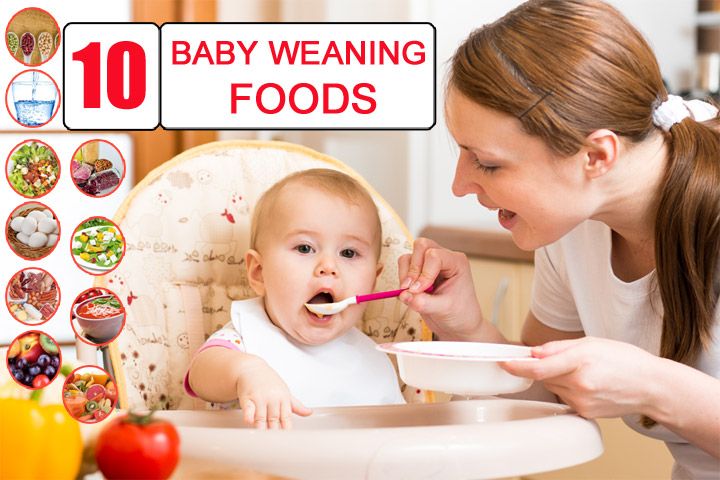
Familiarity is a BIG part of taste and acceptance, and the earlier the exposure to all the different flavors and textures, the greater their acceptance.
If your baby stays on pureed textures for too long, it may be much more difficult to get them to accept different textures later.
In other words, early exposure has a significant impact in shaping food preferences and eating habits that are tracked into childhood and beyond (2).
If you're feeling anxious about offering textured foods from the start and want to take the traditional weaning route where babies are spoon-fed purees or the combination approach (you do you!), here's how to safely move forward from purees to textured foods.
Whatever method you choose, the end goal is to introduce a wide variety of flavors and textures before the age of 1.
Can babies eat finger foods without teeth?
While you might think babies can’t eat foods that aren’t pureed until they have teeth, the reality is they don’t need teeth to enjoy table/finger foods.
I’m not sure if you’re aware of this but we actually chew with our molars, not the front teeth. And if you wait until the molars come in (normally around 12-18 months) to move on to table foods, you would totally miss that critical “window of opportunity” for developing food preferences.
Not to mention, failure to move from purees to textured foods by 9 months may lead to increased risk for feeding difficulties later in life (3).
So how are they able to handle table foods without the molars? With their strong gums! I was totally blown away when I saw them in action!
And it is our responsibility as parents to make sure that the foods are appropriately cooked and served, and that’s what I want to share with you!
Do keep in mind, I’m sharing general timelines & guidelines here. What’s most important is to follow your baby’s lead as every child is so different and they develop at their own pace.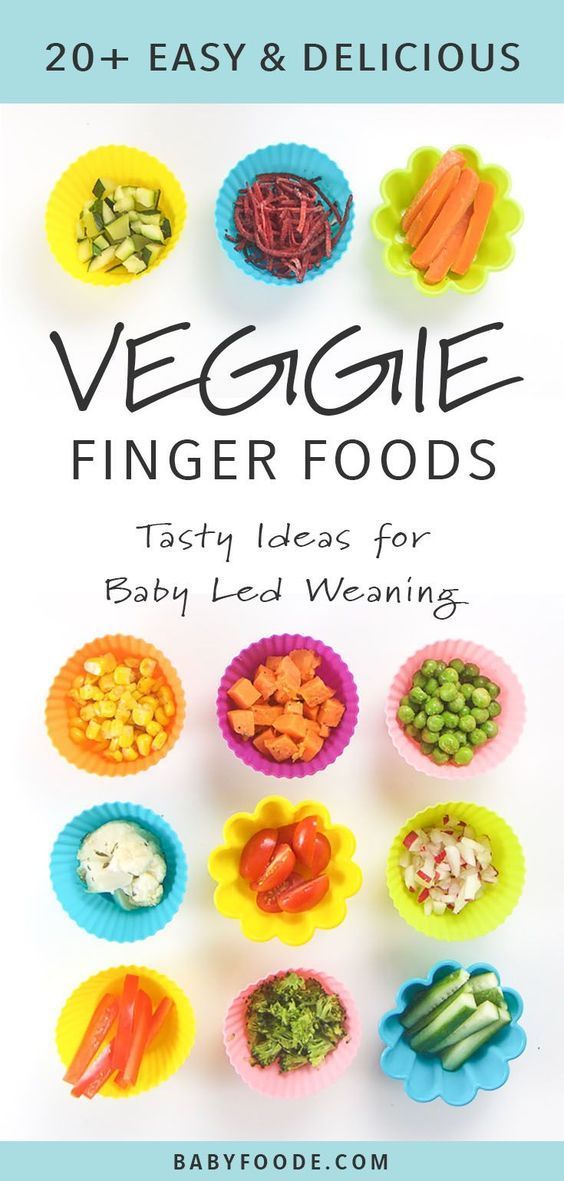
Is your baby 6 months old and up?
Learn all the secrets to starting solids safely while optimizing nutrition!
I NEED IT NOW!
Choking vs. Gagging
Research actually shows that there’s no greater risk of choking with baby led weaning in comparison to the traditional feeding practices (4).
Most important - avoid the choking hazards
for 6-12 months (from the CDC)Keep in mind, choking is different from gagging, which is very common and to be expected. Gagging is a safety mechanism to prevent choking and contrary to how it appears, it doesn’t really bother the babies.
Sit on your hands, remain calm, and let them work through it. Do NOT try to fish out the food from their mouth. Here are some additional tips on how to get through the first month of baby led weaning.
How to Serve Finger Foods to Baby
how to serve zucchini to babiesIn this section, you will learn how to cut and cook the finger foods so they are the appropriate shape and texture according to age.
Finger Foods for 6-8 Month Old Baby
Food shapeCut so that the food is about the size of 1-2 adult fingers pressed together widthwise and the length of an adult pinky finger (or longer).
Contrary to what you might think, serving big pieces of food will actually minimize choking risk and make it easier for your baby to grab with their fist (referred to as the palmar grasp). Initially, everything will likely get demolished, but with practice, your baby will learn to have better control of hand force.
TextureFoods should be firm enough to grasp but soft enough to easily smoosh between two fingers or mash with the tongue on the roof of the mouth.
Roll slippery foods in ground nuts, seeds, flour, etc to make it easier for your baby to pick up. Crinkle cutters can also be very helpful (this tool is great!).
Finger Foods for 9-11 Month Old
By this age, babies are learning to move food side to side within their mouths as well as forward and backward. They are also starting to learn the concept of biting (hopefully anyways).
They are also starting to learn the concept of biting (hopefully anyways).
Your baby is mastering their pincer grasp and able to pick up small pieces of food between the thumb and index finger. Therefore, you can begin to cut food into small bite-sized pieces.
But do continue offering larger pieces of food so they can learn to take bites.
TextureYou can start serving slightly firmer foods by shortening the cooking time for veggies, roasting more often rather than just steaming, etc. Depending on the number of teeth your baby has, chewing ability, and your comfort level, you can start offering finely grated raw fruits and veggies.
If your baby constantly turns into a competitive food eater (like mine did), here are some things you can do to help slow them down:
- Help set pace by placing small amounts of food in front of her at a time either directly on the table/tray or a plate. I personally just took the plate away every time his mouth was full and encouraged him to finish chewing before offering his plate again.
 It was tedious but worked well for us.
It was tedious but worked well for us. - Offer utensils (here are our favorites). Using it requires fine motor skills which will help slow down pace.
You may also be interested in: healthy baby snacks
Finger Foods for 12+ Months
ShapeAgain, try to encourage your child to learn to take bites by not cutting up the food as much. As always, role modeling can do wonders in helping them to learn this new skill.
If your child is continuing to shove food, learn how to teach them to take bites.
TextureYou've done the hard work! At this point your child should be able to handle almost all textures and eating like the rest of the family. Can you start offering crunchy vegetables? Yes! Here's a guide on how to introduce raw vegetables to your little one in a safe and fun way.
Is your toddler becoming picky?
Arm yourself with these strategies that will transform your mealtimes!
YES, PLEASE!
Best First Finger Foods for Baby
Now that you know how to serve the food in an age-appropriate way, here's a master list of specific foods to enjoy with your baby!
Be sure to click on the links for more details on each of the specific foods.
Iron-rich Finger Foods for Baby
Iron is arguably THE most important nutrient for babies and it is one of the primary reasons that we start solids when we do. Be sure to incorporate one of these foods at every meal to help meet their high needs.
- Beef
- Beans
- Chicken
- Eggs
- Lentils
- Salmon
- Sardines
- Shrimp
- Tofu
Related: Top Iron-Rich Foods for Babies and Toddlers
Soft Finger Foods for Baby - Vegetables
- Asparagus
- Beets
- Bell peppers
- Broccoli
- Butternut Squash
- Carrots
- Cauliflower
- Parsnips
- Sweet potato - these sweet potato rounds are so fun!
- Zucchini
And as you see in the image above, do not be afraid to season your baby's food from the start!
Also check out: Vegetables for babies (with 30+ recipes)
Best Baby Finger Foods - Fruits
- Avocado - sliced into wedges or bite-sized pieces
- Apples - serve similar to pears
- Ripe banana - try soaking in peanut butter.
 Be sure to thin it out as globs of peanut butter or any nut butter is a choking hazard
Be sure to thin it out as globs of peanut butter or any nut butter is a choking hazard - Blueberries - smashed
- Grapes - hold off until 9 months and be sure to serve quartered.
- Kiwi - Halves, quarters, bite-sized
- Mangoes
- Melons - large thin rectangles
- Pears
- Peaches
- Strawberries
First foods - Fruits vs. Vegetables
Whole Grains for Babies
Here are some quick and easy ways to incorporate more whole grains into your baby's diet. You will find that a lot of these recipes also contain protein, iron, fruits, and vegetables!
Homemade Baby Oatmeal
Learn how to cook the perfect oatmeal for baby. It's easy, fast, and loaded with vegetables! Serve as is or shape into fingers or balls, baby led weaning style!
Get the recipe
Savory French toast
This savory baby vegetable French toast or eggy bread is an EASY and fun way to use up leftovers. Suitable for babies 6 months and up!
Suitable for babies 6 months and up!
Get the recipe
Baby Banana Pancakes
Made in a blender with simple ingredients, these banana pancakes for babies and toddlers make for a delicious and filling snack or meal. Fluffy and moist, if you are looking for a baby led weaning pancakes recipe, this is it!
Get the recipe
Spinach Pancakes
These green baby pancakes are super easy to make, healthy, and the perfect finger food for baby led weaning.
Get the recipe
Strawberry banana pancakes
Made with simple, healthy ingredients, these strawberry banana pancakes are light, fluffy, and delicious! They contain no added sugar and are a delicious breakfast for the whole family!
Get the recipe
Healthy Blueberry Muffins for Babies
These blueberry baby muffins are sweetened with fruits only and loaded with nutrition! They're soft and moist, making them perfect for babies
Get the recipe
Healthy Beet Muffins for Babies
Made entirely with healthy ingredients, like beans, peanut butter, and no added sugar, these blender muffins can be enjoyed as breakfast, snack, or added to lunchboxes!
Get the recipe
Vegetable Waffles with Peanut Butter
EASY to make, healthy peanut butter vegetable waffles for babies and kids! A great way to enjoy more protein, fat, and veggies for breakfast.
Get the recipe
Savory Baked Oatmeal with Vegetables
This savory baked oatmeal is so easy to make and a great way to enjoy vegetables for breakfast! Perfect for baby led weaning and lunchboxes.
Get the recipe
Healthy Baked Strawberry Oatmeal
Super easy to make, this healthy baked oatmeal recipe with juicy strawberries and bananas is the perfect make ahead breakfast or snack for the whole family!
Get the recipe
Iron-rich baby pasta
A baby pasta recipe that is loaded with iron and vegetables!
Get the recipe
Real-Life Baby Food Ideas
at 7.5- monthsat 10-11 monthsAll the images you see in this article are actual meals I served to my babies.
If you are feeling confused and overwhelmed by what foods to serve, how to prepare foods so they are safe, how to introduce allergens and a wide variety of foods, how to adapt family meals so you don't spend hours slaving away in the kitchen making two separate meals every. single.day, and on and on...
single.day, and on and on...
My 3 month program will save you time, energy, money, and sanity!
I’ve done all the hard work for you so all you need to do is follow the daily and weekly game plan and watch the cooking demos for EVERY.SINGLE.MEAL you will make for 3 months. By doing so you’ll be able to serve all the meals you see here plus 130+ effortlessly!
I’ve also heard from so many parents that an unexpected benefit to following this program for their baby was that it encouraged their older fussy eater(s) to start trying new foods and expanding their food choices.
Do you want to minimize picky eating and set a solid foundation for a lifetime of healthy eating habits?
Check out this 3 month mastering self-feeding program! It’s the closest thing to me being in your kitchen
And be sure to follow me on Instagram for more helpful videos!
Complementary foods at 6 months | Nutrilak
Author of the article
Ksenia Kushalieva
pediatrician, lactation consultant
About the expert
Six months is the latest date for the introduction of complementary foods. If you haven't started giving your baby food other than breast milk or formula, don't delay any further. At this age, the “critical window” for the introduction of complementary foods ends, that is, the most favorable period for this. A later start of complementary foods can lead to a deficiency of nutrients in the baby's body, primarily iron. A child with a delay will develop the skill of chewing thick food. In addition, the introduction of a large number of products allowed for this age increases the risk of allergies.
If you haven't started giving your baby food other than breast milk or formula, don't delay any further. At this age, the “critical window” for the introduction of complementary foods ends, that is, the most favorable period for this. A later start of complementary foods can lead to a deficiency of nutrients in the baby's body, primarily iron. A child with a delay will develop the skill of chewing thick food. In addition, the introduction of a large number of products allowed for this age increases the risk of allergies.
If you start complementary foods at 6 months
-
Choose mashed zucchini, broccoli, or cauliflower as your first food if your baby is gaining weight well and is prone to constipation. Add 1-3 g of vegetable oil to the vegetable puree.
-
For the first feeding, dairy-free rice, buckwheat or corn porridge is suitable if the child is not gaining weight well and is prone to frequent liquefied stools.
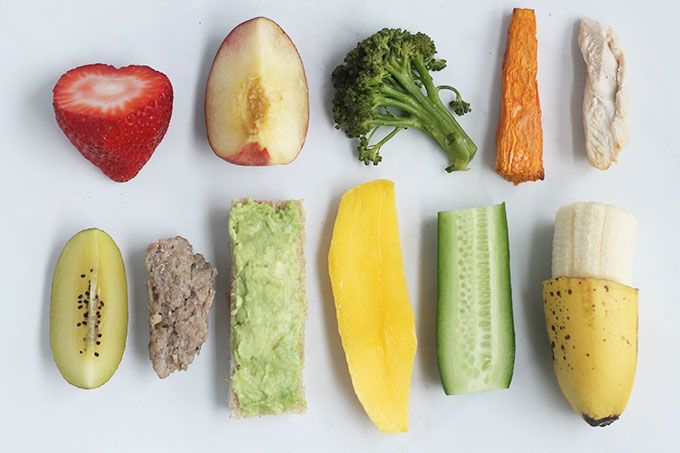 Season the porridge with butter, no more than 3 g.
Season the porridge with butter, no more than 3 g. -
Introduce complementary foods gradually, starting with ½ - 1 teaspoon. For 7-10 days, bring the serving to 150 g - this is the norm for 6 months. If the child does not want to eat the entire portion, do not insist. It is important for you to introduce your baby to a variety of tastes, the main food in the first year of life remains breast milk or milk formula.
-
Complementary foods are not administered if the baby is sick, if he is due or has been vaccinated. A new group of products can be introduced 10-14 days after the previous one has been mastered.
If you continue complementary foods at 6 months
-
At six months, the baby already receives several types of vegetables and cereals. The volume of servings at this age remains the same - 150 g each, but you need to work on a variety of menus. With good tolerance, introduce puree from several types of vegetables, try milk porridge.

-
At six months, new products appear in the baby's diet - meat and fruit puree. It is also allowed to give children's cookies.
Meat puree in the diet of a child at 6 months
Why?
Together with meat, the child begins to receive animal protein - this is the main building material for his growing body, as well as the heme iron he needs. This is iron, which is part of hemoglobin. If it is not enough, the child may develop iron deficiency anemia.
Which types of meat are suitable?
For the first feeding, mashed rabbit, turkey, lamb are suitable - these varieties are less likely to cause allergies, as well as lean pork, beef and veal.
Home or industrial?
At six months, the baby should receive meat in the form of finely ground mashed potatoes, without grains and fibers.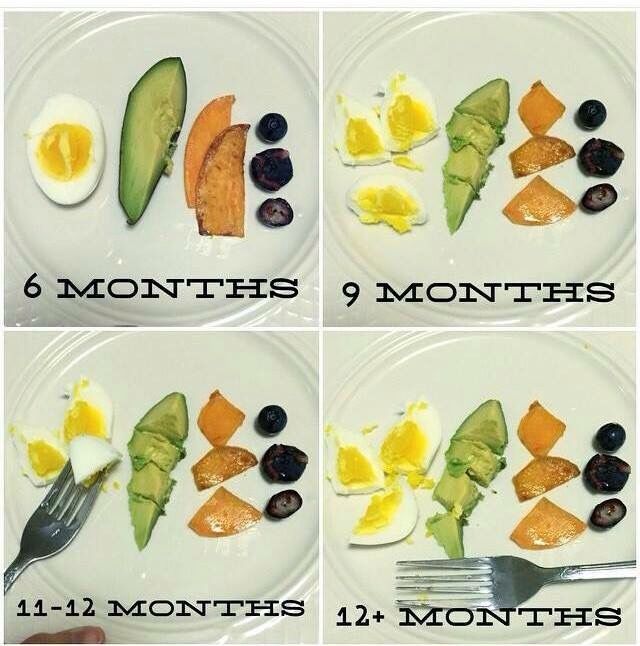 It is difficult to make it at home.
It is difficult to make it at home.
Homemade meat puree will be harder to digest, so its recommended rates are half that of industrial puree.
The advantages of industrial puree include strict quality control of raw materials and technological processes in production.
When buying meat in the market or in a store, you do not know how it was produced, where and under what conditions it was stored, whether antibiotics and growth hormones were added to the animal's food.
If you still choose home-made meat complementary foods, be addicted to the choice of raw materials and carefully monitor compliance with sanitary standards during the preparation of meat.
How to enter?
- Introduce meat complementary foods according to the general rules. First, a monocomponent puree is introduced, that is, consisting of one type of meat. Start introducing meat puree into complementary foods with a quarter teaspoon and double the serving daily.

- In 7-10 days, bring it up to 30 g if you give the baby industrial puree from a can, or up to 15 g if you feed him yourself with chopped boiled meat.
- Mix with vegetable puree to make it easier for your baby to accept a new product. So the child will not be repulsed by the specific taste of the new product, and the meat in combination with vegetables will be better absorbed.
Fruit puree in the diet of a child at 6 months
Why?
Fruits are a source of not only vitamins and minerals, but also dietary fiber, which is necessary for normal digestion. They improve the peristalsis of the baby's intestines, help regular stools and prevent constipation.
Before or after?
For healthy babies, fruit puree is introduced into the menu after meat puree - after 10-14 days. But if the child has constant constipation, which vegetables do not help to cope with, it is possible to introduce fruit puree into complementary foods in the first half of the year, provided that this is not the first complementary food.
Which one first?
For the first feeding, apple puree is suitable, then pear, apricot, plum, peach. Fruit puree of industrial production has all the same advantages over a home-made product as other types of puree: safety in terms of chemical and microbiological indicators, uniform consistency - without fibers and pieces.
How to enter?
- The same rules apply. First, give your baby a quarter teaspoon of puree from one type of fruit (monocomponent). If there are no undesirable reactions of the body, increase the serving by 1-2 teaspoons daily.
- Serving size up to 60 g within 7-10 days.
- Fruit puree can be given to the baby as a treat on its own at the end of the main feeding or added to porridge to improve its taste and, accordingly, the child's appetite.
Baby biscuits in the diet of a child at 6 months
At six months, you can give your baby baby cookies as a snack - no more than 3 g per day (1-2 cookies, depending on size). Like porridge, this is a cereal food, but it has a new taste for the baby. For starters, you can dilute baby biscuits with breast milk or formula. Give cookies as a whole with caution, make sure that the child does not choke on a crumb or a large piece.
Like porridge, this is a cereal food, but it has a new taste for the baby. For starters, you can dilute baby biscuits with breast milk or formula. Give cookies as a whole with caution, make sure that the child does not choke on a crumb or a large piece.
When choosing baby cookies, pay attention to the composition. Many manufacturers add sugar, palm oil, artificial additives to it.
(5 ratings; article rating 3.0)
Serving size for children 0-3 years old. Steps to health. Social project for children and parents, pediatricians
home > Food. Gastroenterology. > The introduction of complementary foods >
With food, the child's body receives the necessary energy, nutrients that provide strong immunity, endurance to stressful situations and environmental factors.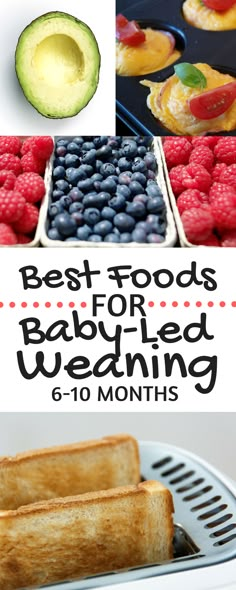 Therefore, mothers often ask questions, does the baby eat enough , what foods can be given and how much should the child eat per feeding? Let's see.
Therefore, mothers often ask questions, does the baby eat enough , what foods can be given and how much should the child eat per feeding? Let's see.
Of course, it's best not to give up breast milk , as it is the most suitable for the digestive system and contains many nutrients.
Breastfed children do not require strict, regular calculation and control of the amount of milk needed or consumed. But if the child is bottle-fed , then up to the age of 10 days one serving is calculated as follows:
age in days times 10 .
At the age of from 10 days to 2 months the volume of serving per day is 600–900 ml i.e. 1/5 of body weight per day 8-12 times feedings.
In the period from 2 to 4 months - 1/6 body weight ( 800-1000 ml ), 7-8 feedings .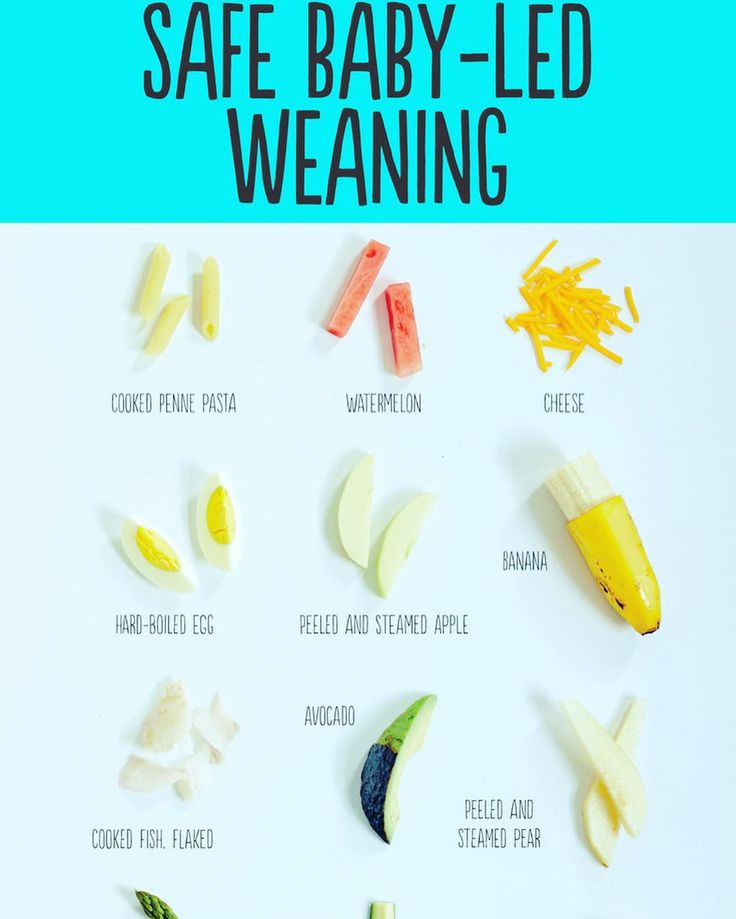
At the age of 4 to 6 months - 1/7 body weight ( 900-1000 ml ) divided by 5-6 feedings .
And finally, from 6 months to 1 year - 1/8-1/9 body weight (portion size 1000-1200 ml ), 5 feedings .
Tea, water, juices are not included.
How much should a child eat: timing of the introduction of complementary foods
In cases where the baby is artificial , complementary foods begin with 5.5–6 months in the amount of 1 teaspoon per day, and then increase the portion.
Within one week, the total is adjusted to 150 g, replacing one feeding with a mixture of complementary foods; it is desirable that this be the second feeding. This means that on the morning of the first feeding, the baby receives formula, and on the next - complementary foods. This sequence is necessary to assess the child's response to complementary foods. The first is recommended to introduce vegetable puree or cereal, depending on the characteristics of the child.
This sequence is necessary to assess the child's response to complementary foods. The first is recommended to introduce vegetable puree or cereal, depending on the characteristics of the child.
From 6 months introduce complementary foods to children who are breastfeeding .
Feeding table
How much should a child aged 1 to 3 eat
The amount of food consumed per day is 1200–1400 ml. Feed the baby at the same time it contributes to normal digestion
Meals - only pureed, boiled or stewed . Protein-rich foods are prepared for breakfast and lunch, cereals and dairy products for dinner.
Gradually, you should switch from liquid pureed food to denser, pieces.
Forbidden: all hot spices and spices, sausages, sausages, sausages, duck meat, lard, fatty pork, lamb, radish, radish, garlic.
Not recommended:
- up to 2 years - all types of tea, coffee, because.
